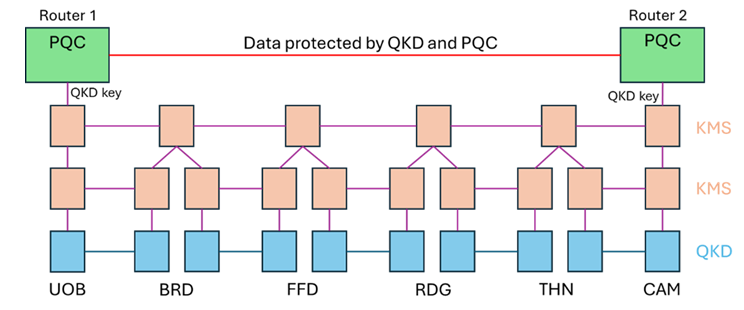
Case study: End-to-End data transmission on the UK Quantum Network, secured by Quantum key distribution and Post-Quantum Cryptography
Cambridge and Bristol were connected with a communication network using the NDFF which secured data from attack by quantum computers by implementing quantum key distribution and post quantum cryptography
There is a clear threat to the security of network communications from the advent of the quantum computer, which is predicted to break current encryption schemes. A potential solution to this is post quantum cryptography (PQC), which derives its security from mathematical complexity and is believed not to be susceptible to attack by quantum computers. In addition quantum key distribution (QKD) derives its security from fundamental quantum mechanics and is information theoretically secure.
Both techniques were used to secure data communications between Cambridge and Bristol over the NDFF, using 5 spans and 4 intermediate nodes of the network, with a total distance of 410km, the longest span being 129km.

A quantum key management system was developed to provide a route from Cambridge to Bristol and provided QKD keys at both ends based on newly standardized protocols. We have worked with Cisco to enable their secure key ingestion protocol (SKIP) to ingest QKD keys at endpoints comprising 10Gb/s Cisco routers within our network, combining with newly developed PQC keys to secure a classical transmission channel between routers protected by both QKD and PQC.
This network forms the basis of connecting the metropolitan scale quantum testbeds in Cambridge and Bristol, and is a key part of the new Integrated Quantum Network hub and underpins the JOINER hub.
Funding information: This work has been funded by UK EPSRC Quantum Communications Hub, project EP/T001011/1.
For further information: contact Dr Adrian Wonfor, ndff@ee.ucl.ac.uk
Published: 4 March 2025
